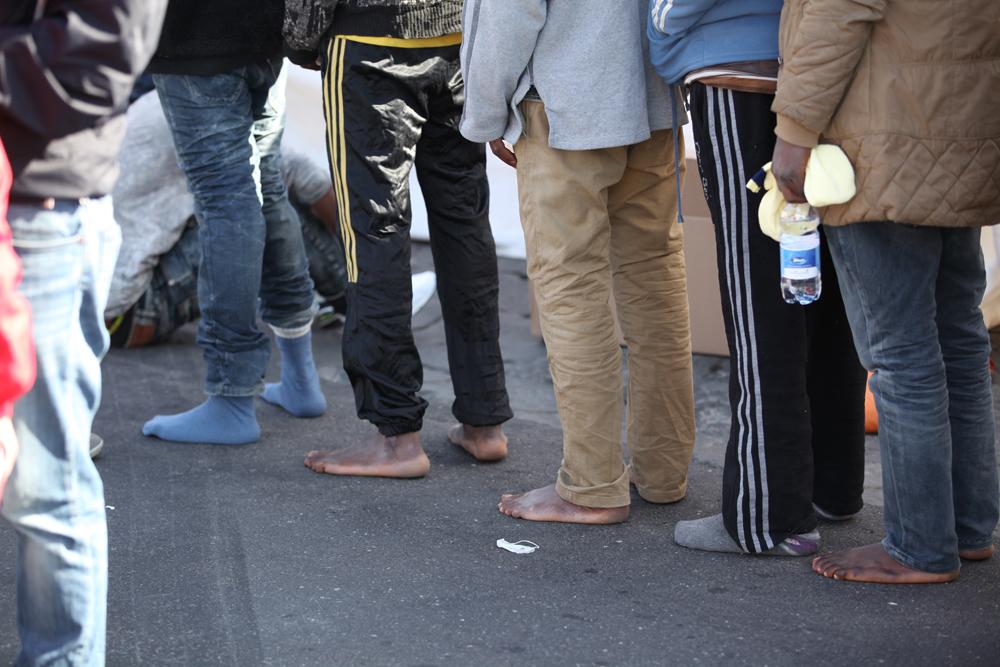Blog
Migration Research Comic-Con 2022: Lessons in storytelling for anti-corruption?
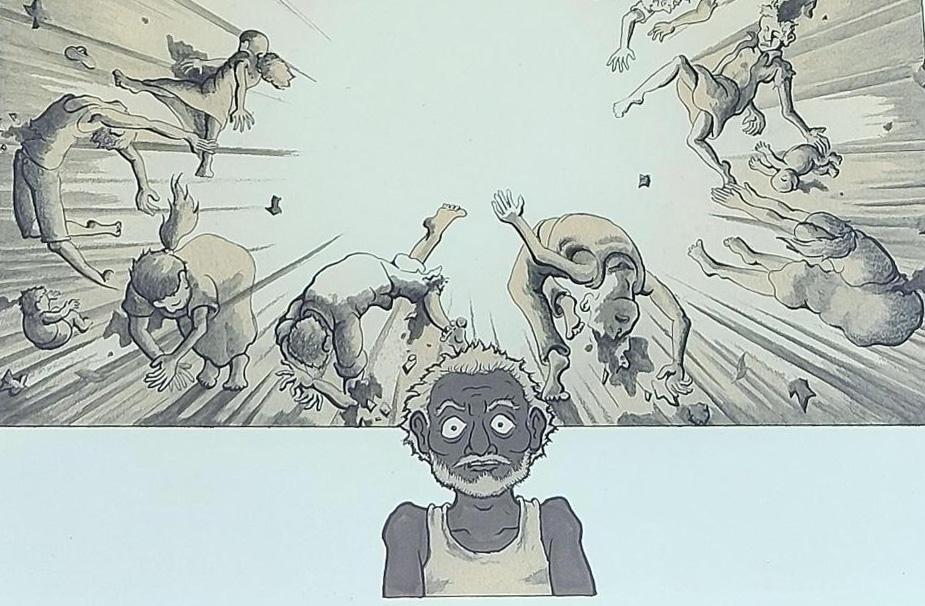
Head in anti-corruption, heart in….
I’ve been U4’s Director for six months. My head is in anti-corruption but my heart still beats for inclusion, gender equality, peace and recovery, governance, health, education, safe migration… I worked on these for 20+ years, and corruption is a knotty part of each. For me, anti-corruption is still a means to achieving these other ends.
Last week I revisited these issues at the (fantastic!) Migration Research Comic-Con at the Royal Geographical Society, London. My aim was to have fun while scouting for ideas for more exciting communication in anti-corruption. Here are a few personal thoughts.
Migration story power – can corruption be next?
Research on, with, and by ‘people on the move’ has a long tradition of storytelling. Many of us have our own ‘migration story’ – whether personal narrative or family epic. Migration research has capitalised on ‘story power’ to turn serious research into creative, engaging outputs – comics, animations, art, and even (old favourite) a Miley Cyrus Wrecking Ball parody.
I think the (often very serious) world of anti-corruption communication could steal ideas from migration research. Like migration, corruption research surfaces stories of how ‘the c word’ changes lives, security, freedom, opportunity. Yet corruption writing often buries these under theory and jargon (I’m still surprised how often corruption people say ‘principal agent problem’).
U4 is already working hard to change this, with graphics and videos like these new animations on corruption in Covid-19 vaccine supply chains. But we – the anti-corruption research and policy world – could do a lot more.
‘Comics are for kids’ (?)
My first taste of migration research comics came in 2019 via these storyboards of tales from Bangladesh, Sri Lanka, Zimbabwe, and Somaliland. They are from the Migrants on the Margins research programme led by Michael Collyer, and drawn by Lindsay Pollock.
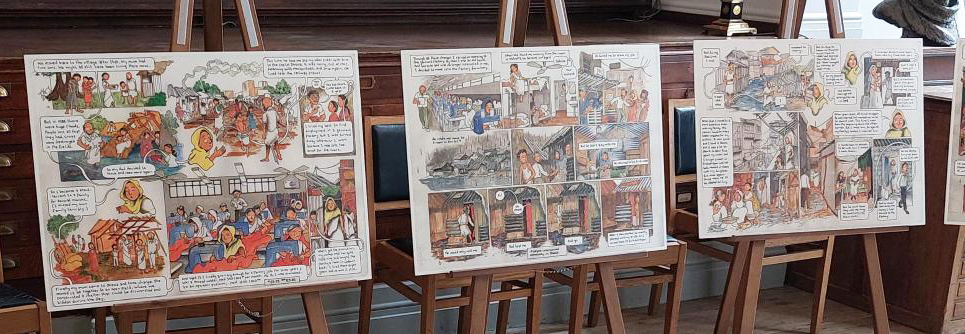
Storyboards from Migrants on the Margins, drawn by Lindsay Pollock.
Credit: Migrants on the Margins/Lindsay Pollock copyrighted
They provoked a response common to many ‘serious’ comics. People read them, and say ‘these are great! ... but who are they actually for?’ The answer: ‘People like you!’
I have seen comics devoured by, and influence the thinking of, small-town officials, national policymakers and donor advisers. The comics convey the same messages as detailed research, but are much more accessible. The ‘Margins’ team also made the award-winning short film Life on the Move and brilliant material for the UK’s school curriculum.
Having seen the power of the ‘Margins’ comics, the DFID-funded Migrating Out Of Poverty (MOOP) programme produced these punchy comics based on years of research on migration routes in and from Africa. Drawn by Maddo, these are complex narratives – agency, exploitation, violence, hope, opportunity, corruption – often all in one journey.
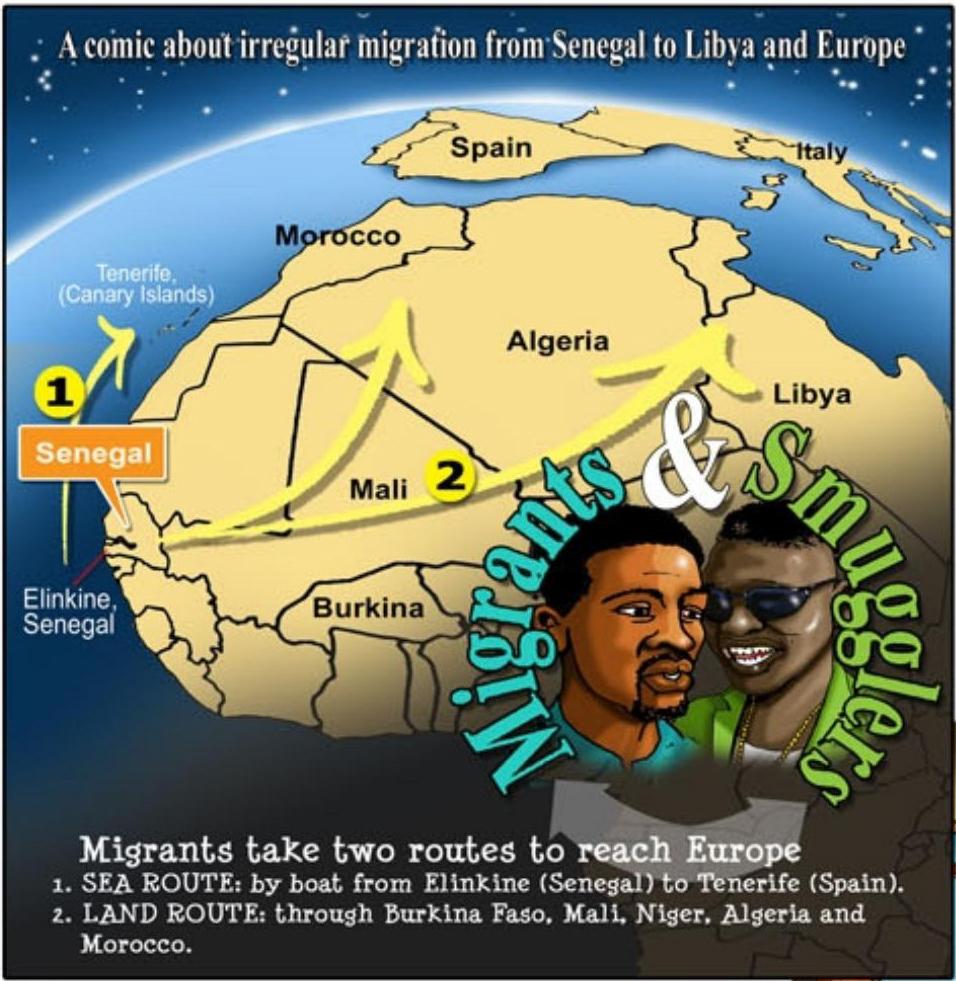
Maddo's illustrations for Migrating Out Of Poverty (MOOP).
Credit: Maddo copyrighted
But the MOOP and Margins comics had a serious intent. They encouraged policymakers not to ignore evidence, and to avoid the tendency to see migrants in binary categories – either innocent/good, or bad/evil.
Anti-corruption suffers a similar ‘binary’ problem, and a lack of nuance in policy about corruption ‘functionality’.
Migration Comic-Con 2020 2021 2022: cheers, tears, lessons
Some of the ‘Margins’ team – Laura Hammond from SOAS, Ben Worku-Dix of Positive Negatives – also made ‘Migration Comic-Con’ happen.
Comic-Con 2022 (postponed during Covid) was ‘more than comics’. There was animation, graphic novels, street art on walls and buses … from the award winning to the spontaneous, including a workshop led by Iris Lim on creating ‘zines’ – small, instant, personal comics.
My blog cannot do justice to the creativity and energy of those presenting. Highlights included the moving, personal Sri Lankan story of Vanni, and the epic graphic novel Illegal by Eoin Colfer (yes, that one), Andrew Donkin and drawn by Giovanni Rigano. Andrew gave an energetic masterclass in how to engage an audience with pictures, words, and ‘making of’ tales.
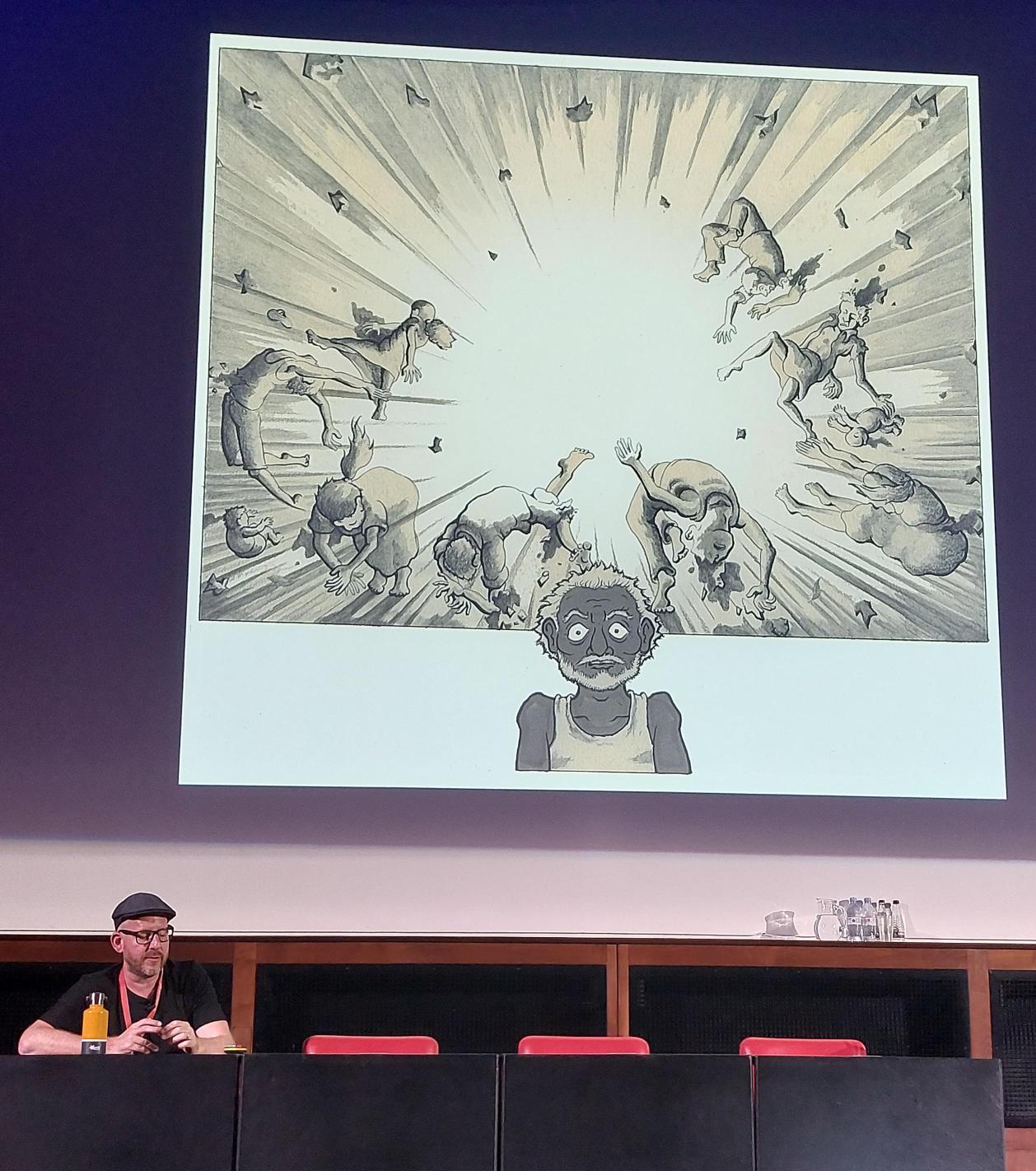
Author Ben Worku-Dix presented his graphic novel, Vanni, about a family's struggles through the Sri Lankan civil war.
Credit: Ben Worku-Dix/Lindsay Pollock copyrighted
I again imagined anti-corruption research stories lighting up the big stage with stunning graphics, jeopardy, hope, emotion, triumph.
And tears… my first was for a tiny instant ‘zine’ with a story arc stretching from Germany 1922 to unaccompanied child migrants in Calais, and the demolition of ‘The Jungle’. Comics have emotional power!
My second tear was watching the award-winning animation for Elton John’s Rocket Man by artist, stand-up comic, all round superstar Majid Adin. Majid’s own migration story is as stunning as his art.

Arriving in the UK from ‘The Jungle’ in Calais, Majid Adin won the competition to produce this incredible animation to accompany Elton John’s song Rocket Man.
Credit: Peter J. Evans/Majid Adin copyrighted
Eyes dried, I scribbled some personal lessons for anti-corruption research communication:
Lesson 1: Composite stories combine narrative punch with ethical communications
‘Composite stories’ (several experiences put together) have real narrative power, and also help ensure the anonymity of very vulnerable people, and reduce risk of reprisals from state or other powers. This includes illustration based on, but obscuring the identify of, real migrants, and representing experiences that were never photographed. These struck me as useful insights for communicating corruption research.
Lesson 2: Collaboration and co-creation are vital
Research communication demands researcher–artist collaboration from start to finish (I say ‘nose to tail’), and rarely works well if researchers hand over their finished tome and ask the creatives to ‘do something with this’. Ideas, energy, creativity, content, should flow in both directions.
This message will cheer communications experts and artists-with-purpose everywhere.
Lesson 3: Tweeting mad ideas is worth it!
Comics thrive on origin stories, and Migration Comic-Con had one. The journey began with a flippant tweet in June 2019, celebrating the ‘Margins’ comics and saying ‘how about a comic-con?’.

A single tweet three years ago led to this wonderful event at the Royal Geographical Society in London!
Credit: Twitter copyrighted
Covid tried to hold them back, but the comics were just too strong….
So where next, anti-corruption?
I think anti-corruption has a communication problem – and will blog about this again – but we can learn from the exciting work of migrants, migration researchers and creatives.
Corruption does have a long tradition in political cartoons (Kenya’s Gado is a superstar), but anti-corruption rarely uses the ‘linear narratives’ of comics.
I have heard of a few anti-corruption graphic novels, including Gbagba by Robtel Neajai Pailey, and this French example on whistle blowing, and know these comics on the political marketplace in South Sudan (drawn by Victor Ndula), focusing on the spoils of war and peace.
I’m on the lookout for more: do you know of any? Are you interested in making them? Starting with your own ‘zine’ (I have!) Of course, the storytelling is as important as the art...
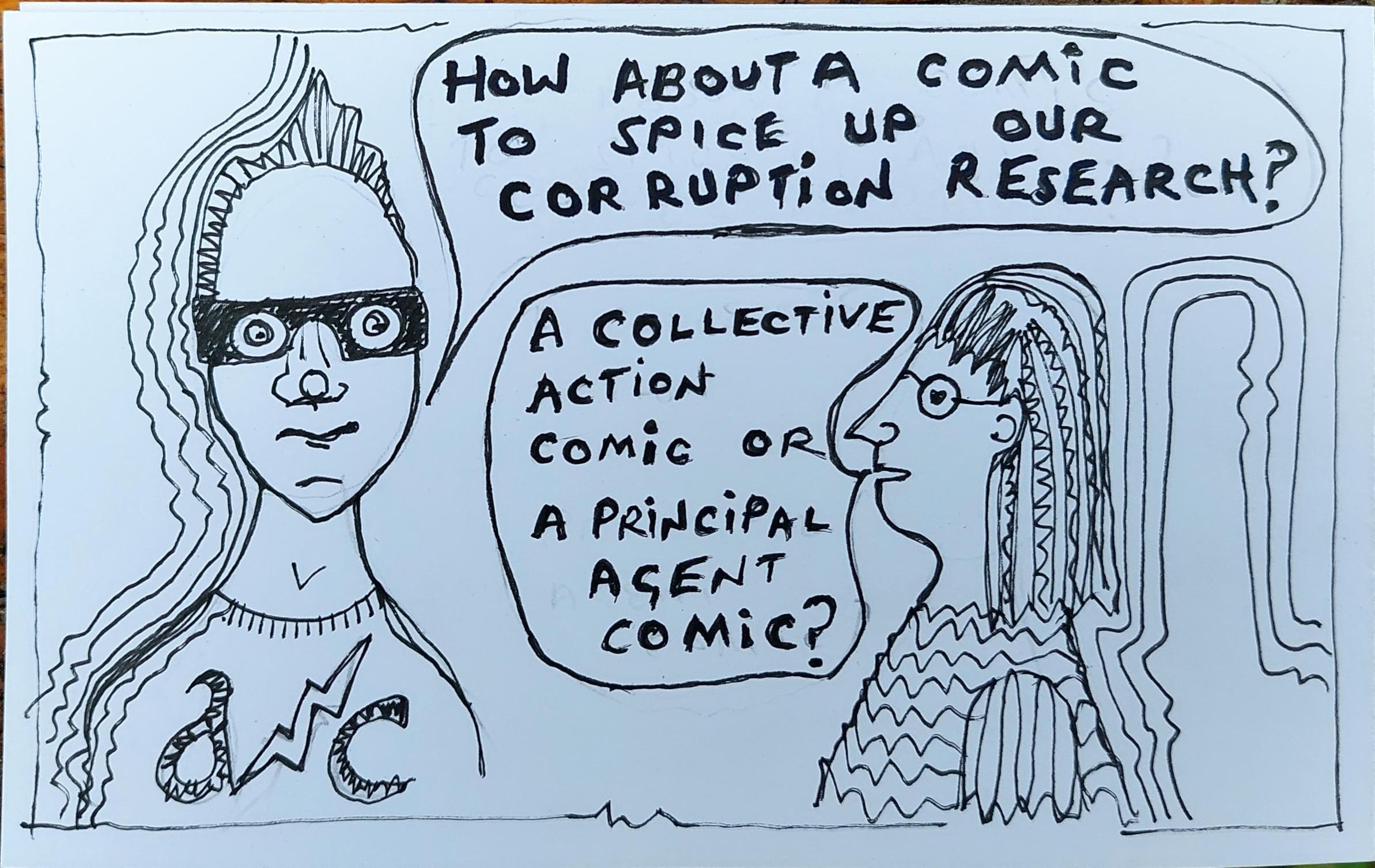
My ‘zine’ starts here…of course, anti-corruption comics will need a compelling narrative as well as pictures!
Credit: Peter J. Evans copyrighted
And how about Anti-Corruption Research Comic-Con… 2025?
Disclaimer
All views in this text are the author(s)’, and may differ from the U4 partner agencies’ policies.
This work is licenced under a Creative Commons Attribution-NonCommercial-NoDerivatives 4.0 International licence (CC BY-NC-ND 4.0)
